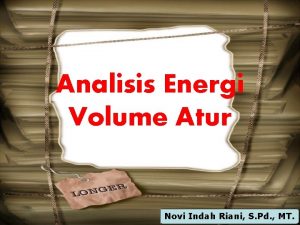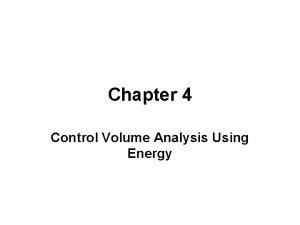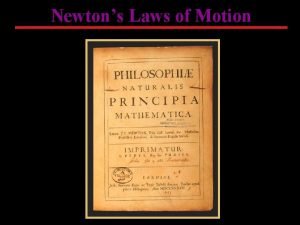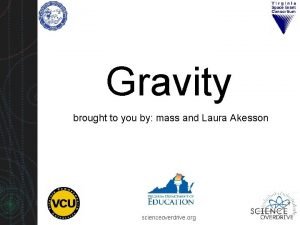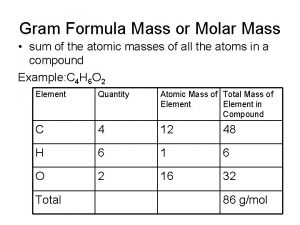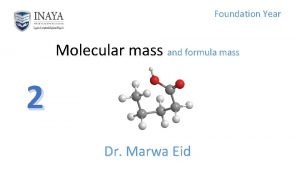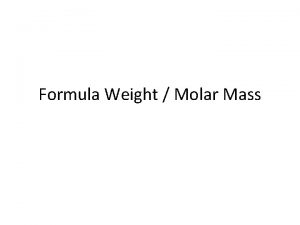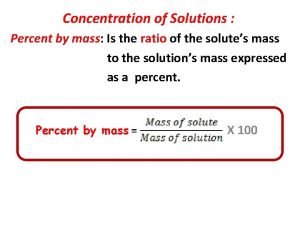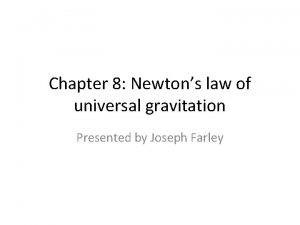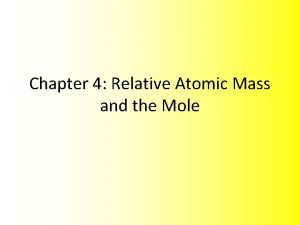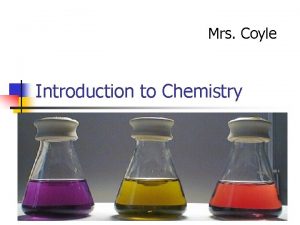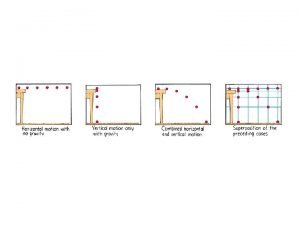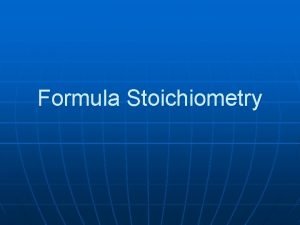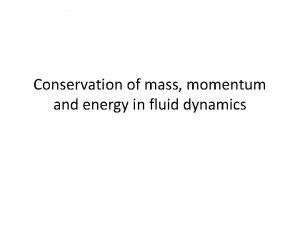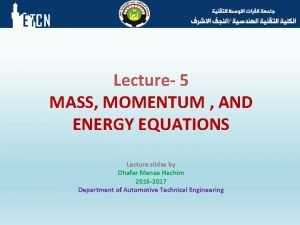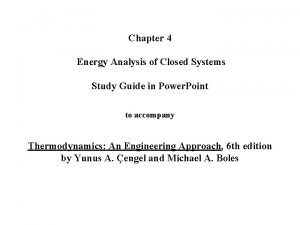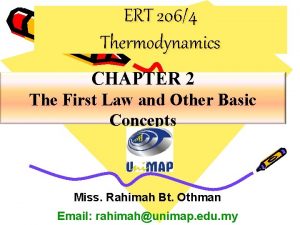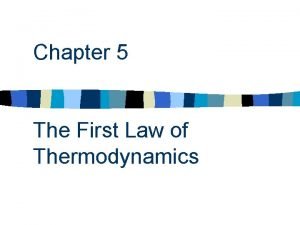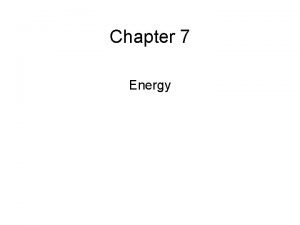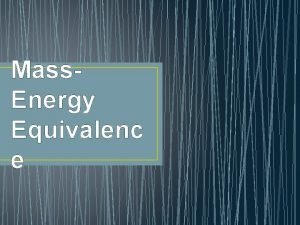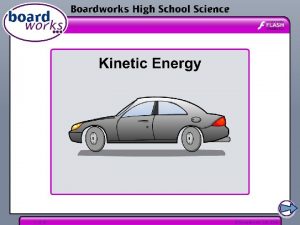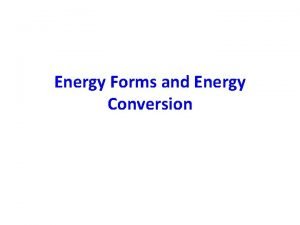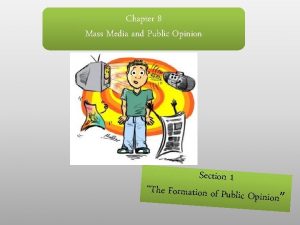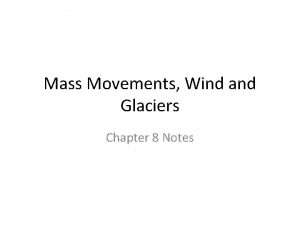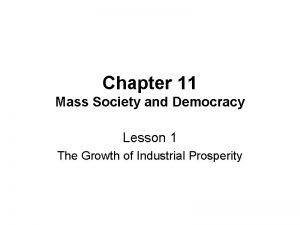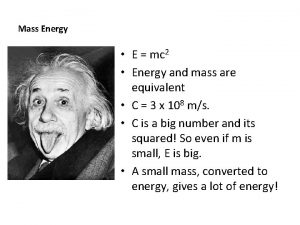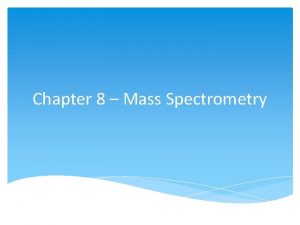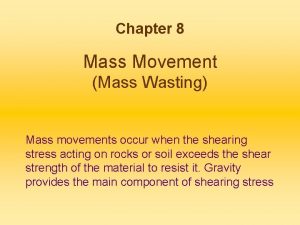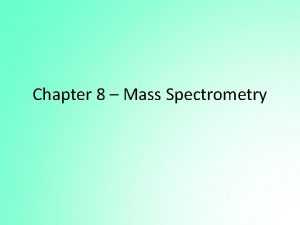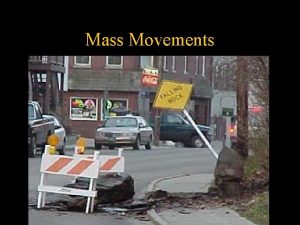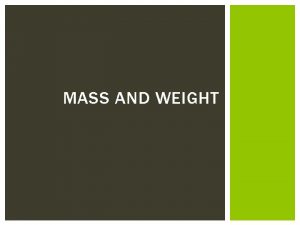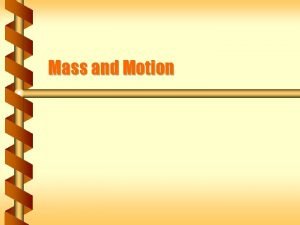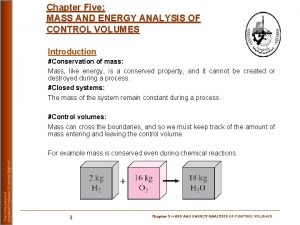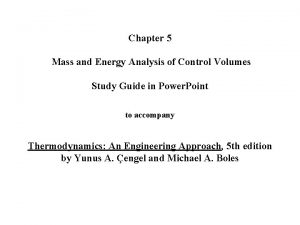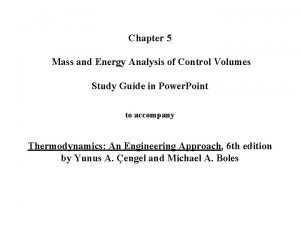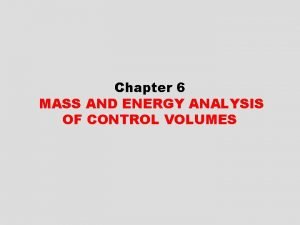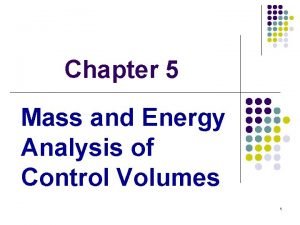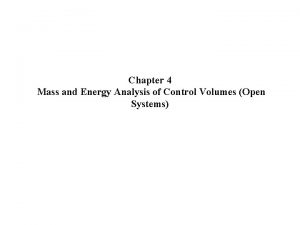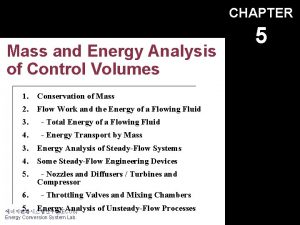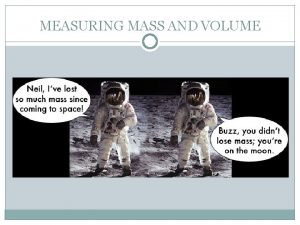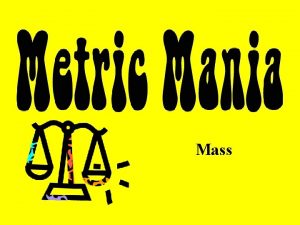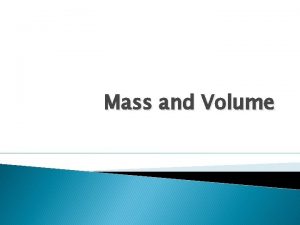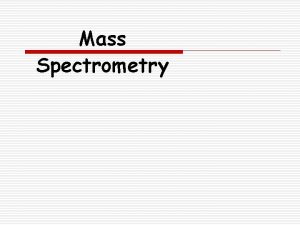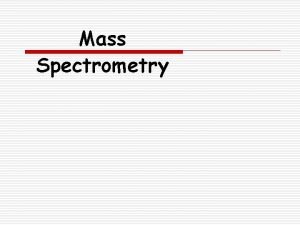Chapter 10 Mass and Energy Analysis of Control




























































- Slides: 60

Chapter 10 Mass and Energy Analysis of Control Volumes (Open Systems)

Conservation of Energy for Control volumes The conservation of mass and the conservation of energy principles for open systems or control volumes apply to systems having mass crossing the system boundary or control surface. In addition to the heat transfer and work crossing the system boundaries, mass carries energy with it as it crosses the system boundaries. Thus, the mass and energy content of the open system may change when mass enters or leaves the control volume. Thermodynamic processes involving control volumes can be considered in two groups: steady-flow processes and unsteady-flow processes. During a steady-flow process, the fluid flows through the control volume steadily, experiencing no change with time at a fixed position. 2

Let’s review the concepts of mass flow rate and energy transport by mass. One should study the development of the general conservation of mass presented in the text. Here we present an overview of the concepts important to successful problem solving techniques. Mass Flow Rate Mass flow through a cross-sectional area per unit time is called the mass flow rate. Note the dot over the mass symbol indicates a time rate of change. It is expressed as where is the velocity normal to the cross-sectional flow area. 3

If the fluid density and velocity are constant over the flow cross-sectional area, the mass flow rate is where is the density, kg/m 3 ( = 1/v), A is the cross-sectional area, m 2; and average fluid velocity normal to the area, m/s. is the Example 10 -1 Refrigerant-134 a at 200 k. Pa, 40% quality, flows through a 1. 1 -cm inside diameter, d, tube with a velocity of 50 m/s. Find the mass flow rate of the refrigerant-134 a. At P = 200 k. Pa, x = 0. 4 we determine the specific volume from 4

The fluid volume flowing through a cross-section per unit time is called the volume flow rate. The volume flow rate is given by integrating the product of the velocity normal to the flow area and the differential flow area over the flow area. If the velocity over the flow area is a constant, the volume flow rate is given by (note we are dropping the “ave” subscript on the velocity) The mass and volume flow rate are related by Example 10 -2 Air at 100 k. Pa, 50 o. C, flows through a pipe with a volume flow rate of 40 m 3/min. Find the mass flow rate through the pipe, in kg/s. Assume air to be an ideal gas, so 5

Conservation of Mass for General Control Volume The conservation of mass principle for the open system or control volume is expressed as or Steady-State, Steady-Flow Processes Most energy conversion devices operate steadily over long periods of time. The rates of heat transfer and work crossing the control surface are constant with time. The states of the mass streams crossing the control surface or boundary are constant with time. Under these conditions the mass and energy content of the control volume are constant with time. 6

Steady-state, Steady-Flow Conservation of Mass: Since the mass of the control volume is constant with time during the steady-state, steady-flow process, the conservation of mass principle becomes or Special Case: Steady Flow of an Incompressible Fluid The mass flow rate is related to volume flow rate and fluid density by For one entrance, one exit steady flow control volume, the mass flow rates are related by 7

Word of caution: This result applies only to incompressible fluids. Most thermodynamic systems deal with processes involving compressible fluids such as ideal gases, steam, and the refrigerants for which the above relation will not be applied. 8

Example 10 -3 Air enters a nozzle steadily at 2. 21 kg/m 3 and 30 m/s and leaves at 0. 762 kg/m 3 and 180 m/s. If the inlet area of the nozzle is 80 cm 2, determine (a) mass flow rate through the nozzle, and (b) exit area of the nozzle. 9

10

Flow work and the energy of a flowing fluid Energy flows into and from the control volume with the mass. The energy required to push the mass into or out of the control volume is known as the flow work or flow energy. The fluid up steam of the control surface acts as a piston to push a unit of mass into or out of the control volume. Consider the unit of mass entering the control volume shown below. As the fluid upstream pushes mass across the control surface, work done on that unit of mass is 11

The term Pv is called the flow work done on the unit of mass as it crosses the control surface. The total energy of flowing fluid The total energy carried by a unit of mass as it crosses the control surface is the sum of the internal energy, flow work, potential energy, and kinetic energy. Here we have used the definition of enthalpy, h = u + Pv. Energy transport by mass Amount of energy transport across a control surface: 12

Rate of energy transport across a control surface: Conservation of Energy for General Control Volume The conservation of energy principle for the control volume or open system has the same word definition as the first law for the closed system. Expressing the energy transfers on a rate basis, the control volume first law is or Considering that energy flows into and from the control volume with the mass, energy enters because net heat is transferred to the control volume, and energy leaves because the control volume does net work on its surroundings, the open system, or control volume, the first law becomes 13

where is the energy per unit mass flowing into or from the control volume. The energy per unit mass, , flowing across the control surface that defines the control volume is composed of four terms: the internal energy, the kinetic energy, the potential energy, and the flow work. The total energy carried by a unit of mass as it crosses the control surface is Where the time rate change of the energy of the control volume has been written as 14

Steady-State, Steady-Flow Processes Most energy conversion devices operate steadily over long periods of time. The rates of heat transfer and work crossing the control surface are constant with time. The states of the mass streams crossing the control surface or boundary are constant with time. Under these conditions the mass and energy content of the control volume are constant with time. Steady-state, Steady-Flow Conservation of Mass: Steady-state, steady-flow conservation of energy Since the energy of the control volume is constant with time during the steady-state, steady-flow process, the conservation of energy principle becomes 15

or 0 or Considering that energy flows into and from the control volume with the mass, energy enters because heat is transferred to the control volume, and energy leaves because the control volume does work on its surroundings, the steady-state, steady-flow first law becomes 16

Often this result is written as where Steady-state, steady-flow for one entrance and one exit A number of thermodynamic devices such as pumps, fans, compressors, turbines, nozzles, diffusers, and heaters operate with one entrance and one exit. The steadystate, steady-flow conservation of mass and first law of thermodynamics for these systems reduce to 17

where the entrance to the control volume is state 1 and the exit is state 2 and mass flow rate through the device. is the When can we neglect the kinetic and potential energy terms in the first law? Consider the kinetic and potential energies per unit mass. 18

When compared to the enthalpy of steam (h 2000 to 3000 k. J/kg) and the enthalpy of air (h 200 to 6000 k. J/kg), the kinetic and potential energies are often neglected. When the kinetic and potential energies can be neglected, the conservation of energy equation becomes We often write this last result per unit mass flow as where and . Some Steady-Flow Engineering Devices Below are some engineering devices that operate essentially as steady-state, steadyflow control volumes. 19

Nozzles and Diffusers For flow through nozzles, the heat transfer, work, and potential energy are normally neglected, and nozzles have one entrance and one exit. The conservation of energy becomes 20

Solving for Example 10 -4 Steam at 0. 4 MPa, 300 o. C, enters an adiabatic nozzle with a low velocity and leaves at 0. 2 MPa with a quality of 90%. Find the exit velocity, in m/s. Control Volume: The nozzle Property Relation: Steam tables Process: Assume adiabatic, steady-flow Conservation Principles: Conservation of mass: For one entrance, one exit, the conservation of mass becomes 21

Conservation of energy: According to the sketched control volume, mass crosses the control surface, but no work or heat transfer crosses the control surface. Neglecting the potential energies, we have Neglecting the inlet kinetic energy, the exit velocity is Now, we need to find the enthalpies from the steam tables. At 0. 2 MPa hf = 504. 7 k. J/kg and hfg = 2201. 6 k. J/kg. 22

23

Example 10. 5 Refrigerant-134 a at 700 k. Pa and 100 C enters an adiabatic nozzle steadily with a velocity of 20 m/s and leaves at 300 k. Pa and 30 C. Determine (a) the exit velocity and (b) ratio of the inlet to exit area. Control Volume: The nozzle Property Relation: Steam tables Process: Assume adiabatic, steady-flow Conservation Principles: Conservation of mass: For one entrance, one exit, the conservation of mass becomes 24

Conservation of energy: According to the sketched control volume, mass crosses the control surface, but no work or heat transfer crosses the control surface. Neglecting the potential energies, we have 25

Steam enters a nozzle at 400°C and 800 k. Pa with a velocity of 10 m/s, and leaves at 300°C and 200 k. Pa while losing heat at a rate 25 k. W. For an inlet area of 800 cm 2 , determine the velocity and the volume flow rate of the steam at the nozzle exit. 400 C 300 C STEAM 800 k. Pa 10 m/s 200 k. Pa Q 26

Turbines Turbine drives the electric generator In steam, gas, or hydroelectric power plants. As the fluid passes through the turbine, work is done against the blades, which are attached to the shaft. As a result, the shaft rotates, and the turbine produces work. If we neglect the changes in kinetic and potential energies as fluid flows through an adiabatic turbine having one entrance and one exit, the conservation of mass and the steady-state, steady-flow first law becomes 27

28

EXAMPLE 10 -6 Steam enters an adiabatic turbine at 8 Mpa and 500°C at a rate of 3 kg/s and leaves at 20 k. Pa. If the power output of the turbine is 2. 5 MW, determine the temperature of the steam at the turbine exit. Neglect kinetic energy changes. EXAMPLE 10 -7 Steam enters an adiabatic turbine at 10 MPa and 500°C and leaves at 10 k. Pa with a quality of 90 percent. Neglect the changes in kinetic energy and potential energies, determine the mass flow rate required for a power output of 5 MW. 29

Compressors and fans are essentially the same devices. However, compressors operate over larger pressure ratios than fans. If we neglect the changes in kinetic and potential energies as fluid flows through an adiabatic compressor having one entrance and one exit, the steady-state, steady-flow first law or the conservation of energy equation becomes 30

Example 10 -8 Nitrogen gas is compressed in a steady-state, steady-flow, adiabatic process from 0. 1 MPa, 25 o. C. During the compression process the temperature becomes 125 o. C. If the mass flow rate is 0. 2 kg/s, determine the work done on the nitrogen, in k. W. 31

Control Volume: The compressor (see the compressor sketched above) Property Relation: Assume nitrogen is an ideal gas and use ideal gas relations Process: Adiabatic, steady-flow Conservation Principles: Conservation of mass: Conservation of energy: According to the sketched control volume, mass and work cross the control surface. Neglecting kinetic and potential energies and noting the process is adiabatic, we have for one entrance and one exit 32

The work done on the nitrogen is related to the enthalpy rise of the nitrogen as it flows through the compressor. The work done on the nitrogen per unit mass flow is Assuming constant specific heats at 300 K from Table A-2(a), we write the work as 33

Throttling devices Consider fluid flowing through a one-entrance, one-exit porous plug. The fluid experiences a pressure drop as it flows through the plug. No net work is done by the fluid. Assume the process is adiabatic and that the kinetic and potential energies are neglected; then the conservation of mass and energy equations become 34

This process is called a throttling process. What happens when an ideal gas is throttled? When throttling an ideal gas, the temperature does not change. It may be noted that the throttling process is an important process in the refrigeration cycle. A throttling device may be used to determine the enthalpy of saturated steam. The steam is throttled from the pressure in the pipe to ambient pressure in the calorimeter. The pressure drop is sufficient to superheat the steam in the calorimeter. Thus, the temperature and pressure in the calorimeter will specify the enthalpy of the steam in the pipe. 35

Example 10 -7 One way to determine the quality of saturated steam is to throttle the steam to a low enough pressure that it exists as a superheated vapor. Saturated steam at 0. 4 MPa is throttled to 0. 1 MPa, 100 o. C. Determine the quality of the steam at 0. 4 MPa. Throttling orifice 1 2 Control Surface Control Volume: The throttle Property Relation: The steam tables Process: Steady-state, steady-flow, no work, no heat transfer, neglect kinetic and potential energies, one entrance, one exit Conservation Principles: Conservation of mass: 36

Conservation of energy: According to the sketched control volume, mass crosses the control surface. Neglecting kinetic and potential energies and noting the process is adiabatic with no work, we have for one entrance and one exit Therefore, 37

Example 10. 8 1. A well-insulated valve is used to throttle steam from 8 MPa and 500 C to 6 MPa. Determine final temperature of steam. 2. Air at 200 psia and 90 F is throttled to the atmospheric pressure of 35 psia. Determine the final temperature of the air. 38

Mixing chambers 60 C In engineering applications, the section where the mixing process takes place is commonly referred to as a mixing chamber. 140 k. Pa 10 C 43 C Energy balance for the adiabatic mixing chamber in the figure is: The T-elbow of an ordinary shower serves as the mixing chamber for the hot- and the cold-water streams. 39

Example 10 -9 Steam at 0. 2 MPa, 300 o. C, enters a mixing chamber and is mixed with cold water at 20 o. C, 0. 2 MPa, to produce 20 kg/s of saturated liquid water at 0. 2 MPa. What are the required steam and cold water flow rates? Steam 1 Mixing Saturated water 3 chamber Cold water 2 Control surface Control Volume: The mixing chamber Property Relation: Steam tables Process: Assume steady-flow, adiabatic mixing, with no work Conservation Principles: Conservation of mass: 40

Conservation of energy: According to the sketched control volume, mass crosses the control surface. Neglecting kinetic and potential energies and noting the process is adiabatic with no work, we have for two entrances and one exit Now, we use the steam tables to find the enthalpies: 41

42

Heat exchangers are devices where two moving fluid streams exchange heat without mixing. Heat exchangers are widely used in various industries, and they come in various designs. The heat transfer associated with a heat exchanger may be zero or nonzero depending on how the control volume is selected. Mass and energy balances for the adiabatic heat exchanger in the figure is: A heat exchanger can be as simple as two concentric pipes. 43

Example 10 -10 Air is heated in a heat exchanger by hot water. The water enters the heat exchanger at 45 o. C and experiences a 20 o. C drop in temperature. As the air passes through the heat exchanger, its temperature is increased by 25 o. C. Determine the ratio of mass flow rate of the air to mass flow rate of the water. 1 Air inlet 1 Water inlet Control surface 2 Water exit 2 Air exit Control Volume: The heat exchanger Property Relation: Air: ideal gas relations Water: steam tables or incompressible liquid results Process: Assume adiabatic, steady-flow 44

Conservation Principles: Conservation of mass: 0(steady) For two entrances, two exits, the conservation of mass becomes For two fluid streams that exchange energy but do not mix, it is better to conserve the mass for the fluid streams separately. Conservation of energy: According to the sketched control volume, mass crosses the control surface, but no work or heat transfer crosses the control surface. Neglecting the kinetic and potential energies, we have for steady-flo 45

0(steady) We assume that the air has constant specific heats at 300 K, Table A-2(a) (we don't know the actual temperatures, just the temperature difference). Because we know the initial and final temperatures for the water, we can use either the incompressible fluid result or the steam tables for its properties. Using the incompressible fluid approach for the water, Table A-3, Cp, w = 4. 18 k. J/kg K. 46

A second solution to this problem is obtained by determining the heat transfer rate from the hot water and noting that this is the heat transfer rate to the air. Considering each fluid separately for steady-flow, one entrance, and one exit, and neglecting the kinetic and potential energies, the first law, or conservation of energy, equations become 47

Pipe and duct flow The flow of fluids through pipes and ducts is often a steady-state, steady-flow process. We normally neglect the kinetic and potential energies; however, depending on the flow situation, the work and heat transfer may or may not be zero. Example 5 -10 In a simple steam power plant, steam leaves a boiler at 3 MPa, 600 o. C, and enters a turbine at 2 MPa, 500 o. C. Determine the in-line heat transfer from the steam per kilogram mass flowing in the pipe between the boiler and the turbine. 1 Steam from boiler Steam to turbine 2 Control surface Control Volume: Pipe section in which the heat loss occurs. Property Relation: Steam tables Process: Steady-flow Conservation Principles: 48

Conservation of mass: 0(steady) For one entrance, one exit, the conservation of mass becomes Conservation of energy: According to the sketched control volume, heat transfer and mass cross the control surface, but no work crosses the control surface. Neglecting the kinetic and potential energies, we have for steady-flow 0(steady) We determine the heat transfer rate per unit mass of flowing steam as 49

We use the steam tables to determine the enthalpies at the two states as 50

Example 10 -11 Air at 100 o. C, 0. 15 MPa, 40 m/s, flows through a converging duct with a mass flow rate of 0. 2 kg/s. The air leaves the duct at 0. 1 MPa, 113. 6 m/s. The exit-to-inlet duct area ratio is 0. 5. Find the required rate of heat transfer to the air when no work is done by the air. 1 Air inlet Air exit 2 Control surface Control Volume: The converging duct Property Relation: Assume air is an ideal gas and use ideal gas relations Process: Steady-flow Conservation Principles: Conservation of mass: 51

Conservation of energy: According to the sketched control volume, heat transfer and mass cross the control surface, but no work crosses the control surface. Here keep the kinetic energy and still neglect the potential energies, we have for steady-state, steady-flow process 0(steady) In the first law equation, the following are known: P 1, T 1 (and h 1), , and A 2/A 1. The unknowns are , and h 2 (or T 2). We use the first law and the conservation of mass equation to solve for the two unknowns. 52

Solving for T 2 Assuming Cp = constant, h 2 - h 1 = Cp(T 2 - T 1) 53

Looks like we made the wrong assumption for the direction of the heat transfer. The heat is really leaving the flow duct. (What type of device is this anyway? ) 54

Example 10 -12 Liquid water at 300 k. Pa and 20 C is heated in a chamber by mixing it with superheated steam at 300 k. Pa and 300 C. Cold water enters the chamber at a rate of 1. 8 kg/s. If the mixture leaves the mixing chamber at 60 C, determine the mass flow rate of the superheated steam required. 55

56

57

58

59

60
 Mass and energy analysis of control volumes
Mass and energy analysis of control volumes Energy energy transfer and general energy analysis
Energy energy transfer and general energy analysis Energy energy transfer and general energy analysis
Energy energy transfer and general energy analysis Relative formula mass of hcl
Relative formula mass of hcl Difference between atomic mass and atomic number
Difference between atomic mass and atomic number Atomic weight of oxygen
Atomic weight of oxygen Atomic number mass
Atomic number mass Control volume analysis
Control volume analysis Stoichiometry example
Stoichiometry example How to calculate percent by mass
How to calculate percent by mass Inertial mass vs gravitational mass
Inertial mass vs gravitational mass Grams to.moles
Grams to.moles Convert mass to moles
Convert mass to moles Molar mass def
Molar mass def Mol to mol conversion
Mol to mol conversion What are the units of molar mass
What are the units of molar mass Mass/mass problems
Mass/mass problems Gravitational mass vs inertial mass
Gravitational mass vs inertial mass Formula mass vs molecular mass
Formula mass vs molecular mass Cl- molar mass
Cl- molar mass Picometer symbol
Picometer symbol Formula mass vs molar mass
Formula mass vs molar mass How to get percent concentration
How to get percent concentration Inertial mass vs gravitational mass
Inertial mass vs gravitational mass Formula mass vs molecular mass
Formula mass vs molecular mass Atomic mass vs molar mass
Atomic mass vs molar mass Stoichiometry worksheet #2 (mole-mass mass-mole problems)
Stoichiometry worksheet #2 (mole-mass mass-mole problems) Does an iron nail gain mass or lose mass when it rusts
Does an iron nail gain mass or lose mass when it rusts A rocket of mass 12000 kg accelerates vertically
A rocket of mass 12000 kg accelerates vertically Formula mass vs gram formula mass
Formula mass vs gram formula mass Formula mass vs gram formula mass
Formula mass vs gram formula mass Cold air mass overtakes warm air mass
Cold air mass overtakes warm air mass Chapter 7 energy conservation of energy
Chapter 7 energy conservation of energy Fluid
Fluid Chapter 5 thermal energy
Chapter 5 thermal energy Conservation of mass momentum and energy equations
Conservation of mass momentum and energy equations Thermal energy and mass
Thermal energy and mass Product control
Product control Negative control
Negative control Control flow error
Control flow error Energy analysis of closed systems
Energy analysis of closed systems Thermodynamics chapter 2
Thermodynamics chapter 2 Enthalpy vs internal energy
Enthalpy vs internal energy The most energy per unit mass can be extracted from
The most energy per unit mass can be extracted from How does the mass-energy equation e= mc 2relate to fission?
How does the mass-energy equation e= mc 2relate to fission? Kinetic energy equation rearranged for velocity
Kinetic energy equation rearranged for velocity Mass energy insight
Mass energy insight Work and energy section 2 describing energy answer key
Work and energy section 2 describing energy answer key Primary energy and secondary energy
Primary energy and secondary energy Hypdro
Hypdro Helmholtz free energy
Helmholtz free energy Renewable energy and energy efficiency partnership
Renewable energy and energy efficiency partnership What is potential energy
What is potential energy Potential energy of a spring at equilibrium
Potential energy of a spring at equilibrium Kinetic energy and potential energy formula
Kinetic energy and potential energy formula Conservation of mechanical energy
Conservation of mechanical energy Eroei
Eroei Chapter 8 mass media and public opinion worksheet answers
Chapter 8 mass media and public opinion worksheet answers Chapter 8 mass media and public opinion worksheet answers
Chapter 8 mass media and public opinion worksheet answers Examples of mass movement
Examples of mass movement Mass society and democracy
Mass society and democracy
